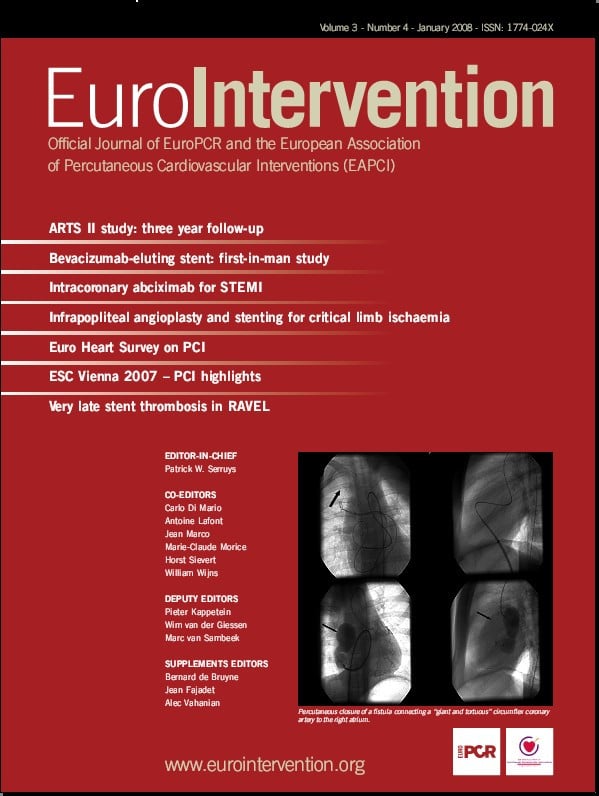Abstract
Aims: Since 1992, a registry has collected data on trends in interventional cardiology within Europe. This 14th report presents aggregated data on cardiac catheter procedures in 30 European countries in the year 2005.
Methods and results: Questionnaires were distributed yearly to all national societies of cardiology represented in the European Society of Cardiology. The goal was to collect the case numbers of all local institutions and operators. The overall numbers of coronary angiographies continue to increase throughout the European community. For percutaneous coronary intervention (PCI) procedures, the same holds true with a marked difference between the nations. In five years the use of drug eluting stents has raised from 57 cases to more than 221,000, representing one third of all stenting procedures.
Mortality has remained unchanged but other complications have significantly decreased over years. From the noncoronary procedures, closure of the patent foramen ovale has shown almost doubled in the past five years.
Conclusions: Interventional cardiology in Europe is ever expanding, in part by the continuous growth in the eastern European countries. Mortality remains low and other procedure-related complications decrease. Among the noncoronary procedures, percutaneous shunt closures, in particular, PFO closure, increased most during the last decade.
Introduction
Few reliable data exist about trends in European interventional cardiology.1-15 The Working Group on Interventional Cardiology of the European Society of Cardiology has published yearly surveys on percutaneous cardiac interventions in Europe since 1992. The reports of these interventions in 2005 represents the 14th edition of these yearly papers and summarises catheter-based cardiac interventions with an overview of specific interventions in 30 European countries, the majority of which are members of the European Society of Cardiology (ESC).
Methods
A detailed questionnaire, together with instructions and examples for completion, was sent to the presidents or designated delegates of the national societies of cardiology represented in the European Society of Cardiology (32 countries). From these national leaders it was distributed within each country to all facilities performing diagnostic or interventional cardiac catheterisation. A summary data sheet, supplied by the national representatives, was used to aggregate data per country. These forms were available online at ESC web services. Finally, this data was entered into the central database and analysed. In the case of missing or incomplete data, the national representatives were reminded repeatedly. In June 2007, the registry was closed for the 2005 report. The definitions of diseases and procedures were those of previous reports. Prior to submission for publication, the national representatives reviewed the figures of the manuscript for accuracy.
Results
FIGURES FOR THE YEAR 2005
The major coronary procedures (coronary angiography, coronary angioplasty [PCI] and coronary stenting) are listed for each country in Table 1.
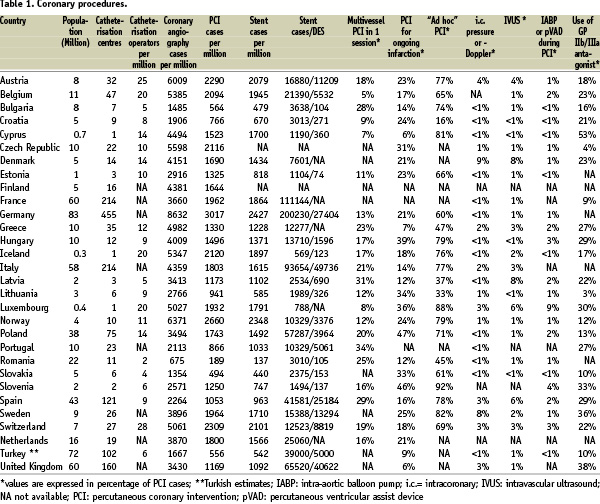
Catheterisation facilities
The number of cardiac catheterisation centres per million inhabitants in Europe remained unchanged in 2005 (2.4±1.2) compared to 2004, with the highest density in Germany (5.5) and the lowest in Romania (0.5). The number of cardiac catheterisation rooms per million inhabitants in Europe in 2005 remained virtually identical to 2004 (3.2±1.7) with the highest density in Iceland (6.7) and the lowest in Romania (0.8). A mean of 1,178±364 coronary angiographies and 463±154 PCIs were performed per catheterisation room. The mean numbers of operators per million inhabitants were 11.9±7.1 and ranged from two in Romania to 29 in Switzerland.
Coronary angiography
A total of 2,298,762 coronary angiograms were performed in Europe in 2005 (2,238,478 in 2004), which corresponds to a 3.3-fold increase since 1992 and a 2.7% increase compared with 2004. This represents 4,030 angiograms per million inhabitants (3,928 in 2004). With the exception of Luxembourg and Croatia, the population adjusted numbers of angiograms increased in all European countries. In 2005, Hungary reported the highest rise with 40%.
Coronary angioplasty
A total of 912,801 PCI procedures were reported for 2005, a 3.1% increase compared with 2004 (Table 2).
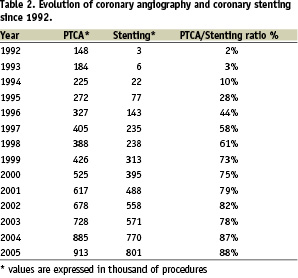
The mean population-adjusted number in 2005 was 1,601 procedures per million inhabitants, representing an increase of 2.5% compared with 2004. As in 2004, the smallest numbers of procedures per million people were reported in countries from the former Warsaw Pact, i.e., Romania (189), Bulgaria (564), and Slovakia (494). With the exception of Belgium and Croatia, all countries reported increases in procedures. Some European countries reported particularly high relative increases (Bulgaria +33%, Estonia +51% and Hungary +20%). “Ad hoc” procedures accounted for 65% of all PCIs (46% in 2004). The mean ratio of PCIs to coronary angiograms was 0.40 (2004: 0.41). The ratio of PCIs to coronary angiograms ranged from 0.27 in Greece to 0.55 in France. Multivessel interventions in one session remain unchanged from 2004 (18%). Interventions for acute myocardial infarction in 2005 accounted for 17% of all coronary procedures (19% in 2004).
Coronary stenting
A total of 801,215 stenting procedures were reported in 2005, resulting in an increase of 4% compared with 2004 (769,766 procedures) (Table 2). The ratio of coronary stenting to PCI procedures averaged 0.87 (2004: 0.85). Most countries reported ratios of 0.70 or above. Drug eluting stents, introduced in 2001, were used overall in about one third (26%) of stenting procedures in 2005; the highest rate being seen in Sweden (85%), the lowest in Bulgaria and Romania (3%). (Figure 1)
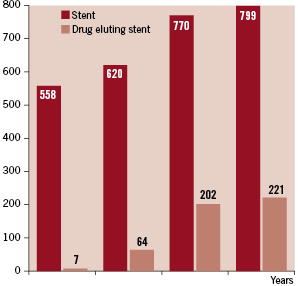
Figure 1. Use of (drug eluting) stents. The overall numbers of percutaneous coronary interventions with implantation of >1 stent or >1 drug eluting stent are depicted in thousands for 2002 to 2005.
Noncoronary interventions
The major noncoronary procedures (alcohol ablation for septal hypertrophy, valvuloplasty, shunt occlusion, coarctation angioplasty and atrial appendage occlusion) are listed in Table 3.

Among these, percutaneous closure of patent foramen ovale (PFO) has shown a constant progression since 2000 (1,625 cases) to 2005 (3,353 cases, +106% since 2000, +26% since 2004). Switzerland, with 71 cases per million inhabitants is the leading country in Europe. Percutaneous atrial septal defect (ASD) closure parallels PFO closure at somewhat lower rates, increasing from 1,058 cases in 2000 to 3,339 cases in 2005, representing an increase of 215% from 2000 to 2005 and 3% during the last reported year. Norway, with 76 cases per million inhabitants is the leading country in Europe.
Other devices
Other therapeutic devices (directional atherectomy, rotablator, laser catheter or wire, ultrasound therapy, brachytherapy, clot catcher/remover) were reported in a total of 15,645 cases (12,795 in 2004) in 2005. There were no significant changes over the last decade. The two diagnostic techniques, intravascular ultrasound and intracoronary pressure measurements, remain the most frequently used techniques in addition to balloon and stent.
Complications
Mortality has remained virtually unchanged since 1992, and was reported at 0.3% in 2005 (2,919 cases per 912,801 PCI). The need for emergency coronary artery bypass grafting (CABG) has slightly decreased to 0.2%. The incidence of PCI-induced myocardial infarction was reported at 0.6% (5,622 cases per 912,801 PCI).
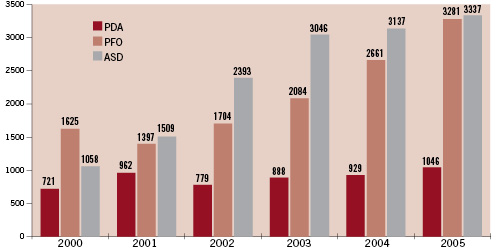
Figure 2. Percutaneous shunt closures. The overall numbers of percutaneous PDA/PFO/ASD closures are depicted for 2000 to 2005.
Discussion
Since its inception by the European Society of Cardiology, the aim of this presented registry has been to demonstrate availability and use of cardiovascular diagnostic and therapeutic procedures within Europe. It provides a unique opportunity to learn about the case numbers of such procedures in all institutions and for all operators, representing a target-population of more than 570 million Europeans. The EuroHeart Survey on Percutaneous Coronary Intervention (EHS-PCI), launched in 2006 collects real-time case per case recording using standardised questionnaires in selected centres. The two registries should be perceived as complementary tools.
In comparison to the predicted values in last year’s report,14 growth has slowed down slightly (–0.3% for coronary angiographies, –1.4% for coronary angioplasty and –3.7% for coronary stenting). The use of drug eluting stents rose to more than 221,000 cases in 2005. Once again, a large variability was reported, ranging from Bulgaria (3%) to Sweden (86%), with a European mean of about 30%. The impact of safety concerns regarding drug eluting stents voiced since 2006 remains to be seen.
For noncoronary procedures, only closure of atrial shunts have shown a significant and constant progression during the past five years. This trend probably translates the fact that the simpler and safer occlusion techniques get, the more lightly decisions to close in particular PFOs are being taken. This is bound to continue in the future.
Limitations
Registry data are approximate. Sources of potential error include missing external validation of the raw data provided by the local institutions and communication errors between the institutions, national coordinators, and the central database. Under-reporting of complications is likely. However, the involvement of the national societies of cardiology ensures conformity with national registries and statistics, and thus guarantees the best level of accuracy currently available for elementary data on coronary angiography, coronary angioplasty, coronary stenting, and noncoronary catheter-based procedures.
Acknowledgement
We are indebted to all the representatives of the national societies of cardiology who participated in this survey. Furthermore we acknowledge the tremendous effort of all individual centres in collecting the surveyed data and completing the questionnaires. The principal data coordinators for each individual country participating in this survey are in alphabetical order: Austria: V. Mühlberger, Belgium: V. Legrand, Bulgaria: J. Jorgova, Croatia: A. Ernst, The Czech Republic: M. Zelizko, Cyprus: C. Zambartas, Denmark: S. Helqvist, Estonia: M. Peeba, Finland: H. Vanhanen, France: J.M. Lablanche, Germany: F. van Buuren, Greece: E. Lazaris, Hungary: G. Fontos, Iceland: K. Eyjolfsson, Italy: F. Piscione, Latvia: A. Erglis, Lithuania: R. Navickas, Luxembourg: J. Beissel, The Netherlands: K. Koch, Norway: T. Melberg, Poland: A. Witkowsky, Portugal: P. Lino, Romania: D. Deleanu, Slovakia: V. Fridrich, Slovenia: M. Kenda, Spain: R. Lopez-Palop, Sweden: T. Nilsson, Switzerland: H. Rickli, I. Reho, M. Maeder, Turkey: M. Degertekin, United Kingdom: P. Ludman.
